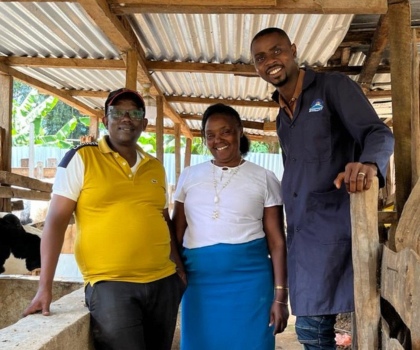#VETSVolunteerVoices aims to bring you the stories of our passionate VETS program volunteers from the field. Meet Dr. Muller Fotsac (DVM), an Animal Health Advisor Volunteer who spent 6 months in rural Kenya (January - June 2024).
Recently, we had the opportunity to sit down with Dr. Muller Fotsac, a veterinarian and PhD candidate who spent six months in Kenya as a VETS volunteer. During our conversation, Muller reflected on his work with rural dairy farmers from January to June 2024, which focused on improving milk production, biosecurity, and animal welfare. His volunteer experience not only deepened his own epidemiological research but also made a lasting difference in the communities he served. Here, we share some of Muller’s reflections and insights from his time in Kenya.
A Dream Realized: The Decision to Volunteer
Muller's decision to volunteer with VWB’s VETS program was driven by a deep passion for dairy farming and his desire to make a difference. "Volunteering with VWB was a dream I needed to achieve," he says. "After following VWB's activities on social media for a while, I knew I wanted to contribute to the organization's work in improving dairy farming practices in Kenya."
In fact, his PhD thesis on the influence of mastitis on raw milk quality aligned perfectly with his placement at Meru Dairy and Wakulima Dairy in Kenya. "I was eager to discover Kenyan dairy culture and its challenges," he adds, "and it felt like the right time to share my knowledge."
The Day-to-Day: Supporting Farmers in Meru and Nyeri
During his six-month placement, Muller worked with two dairies—Meru Dairy Union in Meru County and Wakulima Dairy Cooperative in Nyeri—spending three months at each. His primary role was to support farmers and extension officers through training and farm visits. At Wakulima Dairy in Nyeri, his days began with meetings at 9 AM, followed by a mix of group training sessions and farm visits. In Meru, his schedule was similar, but the activities were more segmented—either group training or farm visits, but rarely both on the same day.
Muller focused on key topics such as mastitis prevention, antimicrobial resistance, and proper feeding techniques. "In both regions, poor feeding practices were a significant challenge, leading to low milk production and, in Meru, milk rejections due to failed tests."
 PHOTO: Muller with Vinsensa, whom he trained in CMT.
PHOTO: Muller with Vinsensa, whom he trained in CMT.
 PHOTO: Muller training Nyeri farmers in cow nutrition.
PHOTO: Muller training Nyeri farmers in cow nutrition.
 PHOTO: Muller visiting the Mukindi dairy farm in Meru.
PHOTO: Muller visiting the Mukindi dairy farm in Meru.
Tackling the Challenges of Dairy Farming in Kenya
The farmers Muller worked with faced several challenges, particularly in feeding and mastitis management. "In Meru, we observed many cases of milk rejection due to poor feeding practices, such as relying on over-dried maize stovers (i.e., the leftover stalks and leaves of crops) which lack nutritional value," he explains.
One specific instance stands out in Muller's memory. Farmers from the New Nthimbiri cooperative in Meru reported a high rate of milk rejection after feeding their cows exclusively with over-dry maize stovers, which had replaced the more nutritious Napier grass due to local shortages. After visiting five affected farms, Muller and his team advised the farmers to switch to greener Napier grass, along with protein-rich fodder like sweet potato vines, desmodium leaves, and Mexican tournesol (Tithonia diversifolia).
Three weeks later, during a follow-up training, Muller received positive feedback from three of the five farmers they had visited. These farmers reported no further milk rejections, thanks to the new feeding strategies. "It was an encouraging moment for me," Muller recalls, "seeing how simple changes could lead to significant improvements."
Improving Milk Production and Reducing Costs
Poor feeding practices were a widespread issue in both Meru and Nyeri, where many farmers were unaware of the optimal dairy meal formulas for feeding cows. "We found that farmers often gave inappropriate quantities of dairy meals, along with low-quality fodder," Muller explains. "This led to low milk production and high production costs."
 PHOTO: Muller at the Nderitu dairy farm in Nyeri, where he advised the farmers on overcoming challenges with silent heat, cow nutrition, and the high cost of feeding.
PHOTO: Muller at the Nderitu dairy farm in Nyeri, where he advised the farmers on overcoming challenges with silent heat, cow nutrition, and the high cost of feeding.
By introducing a balanced feeding formula, Muller and his team helped farmers optimize their feeding practices. According to the dairy farmers, these trainings significantly reduced their cost of production and the number of milk rejections at both farm and cooperative levels. As Muller notes, "Improved feeding practices were one of the most effective ways to help farmers boost their milk production and improve the quality of their dairy output."
Memorable Moments: A Personal Impact
One of Muller's standout experiences involved working with farmers in Meru who were struggling with milk rejections due to alcohol and density test failures. After identifying poor feeding as the root cause, Muller and his team introduced better feeding strategies that led to immediate improvements. "Three weeks after our visit, the farmers reported that the milk rejections had stopped entirely. It was a powerful reminder of how knowledge can transform livelihoods."
Introducing New Tools: Raising Awareness of Mastitis Testing
Another challenge was the lack of awareness around the California Mastitis Test (CMT), a simple tool that helps farmers detect subclinical mastitis. In Meru County, only 10% of the farmers trained had heard of the CMT test, and a mere 5% had ever used it.
 PHOTO: Muller training the Nduma Farmer's Group in Nyeri on good feeding practices and mastitis prevention.
PHOTO: Muller training the Nduma Farmer's Group in Nyeri on good feeding practices and mastitis prevention.
To tackle this, Muller carried CMT kits with him during farm visits and training sessions. He demonstrated how to use the test and helped farmers practice detecting mastitis. "Bringing the test directly to the farmers was crucial in raising awareness and showing them how easy and effective it could be in preventing mastitis," he explains.
Overcoming Obstacles: Adapting to Local Realities
Volunteering in Kenya wasn’t without its challenges. At times, Muller found that few farmers attended scheduled training sessions, often due to conflicts with milking times. “In these cases, we adapted by either starting training sessions earlier or visiting farms directly,” he says.
Language barriers also posed difficulties, with some interpreters lacking a background in animal health. To address this, the partner dairy provided technical translators who could more accurately convey the training content. “This made a big difference in ensuring that farmers understood the material,” Muller reflects.
Advice for Future Volunteers
For those considering a VETS volunteer placement, Muller emphasizes the importance of embracing the local culture and maintaining respect for the community. "Volunteering is an exchange of culture and knowledge. Respect and adaptability are key to successful integration."
He also encourages volunteers to have faith in the impact of their work. “Farmers look to us for guidance, and the improvements they see on their farms are a reflection of our dedication.”
 PHOTO: Muller poses with Damari Moses at her dairy farm in Meru - Damari had earlier attended Muller's cow feeding, nutrition and hygiene trainings.
PHOTO: Muller poses with Damari Moses at her dairy farm in Meru - Damari had earlier attended Muller's cow feeding, nutrition and hygiene trainings.
VETS is an 8-year initiative (2020-2028) to improve the economic and social well-being of marginalized people, particularly women and girls, in 6 countries across Africa and Asia. In collaboration with local partners, the program is implemented through 190 Canadian volunteers on international assignment and is generously funded by Global Affairs Canada. Learn more.





